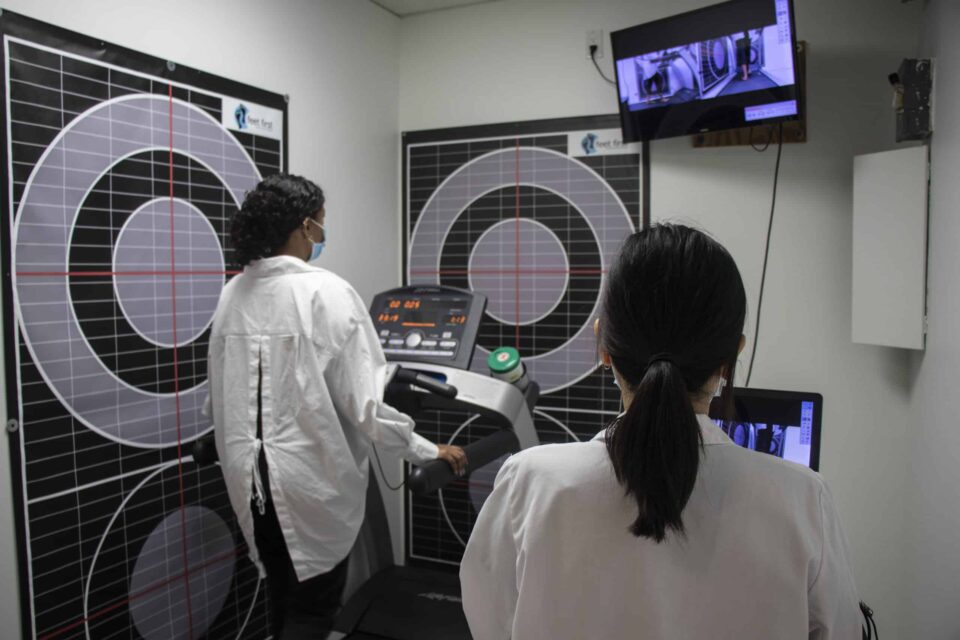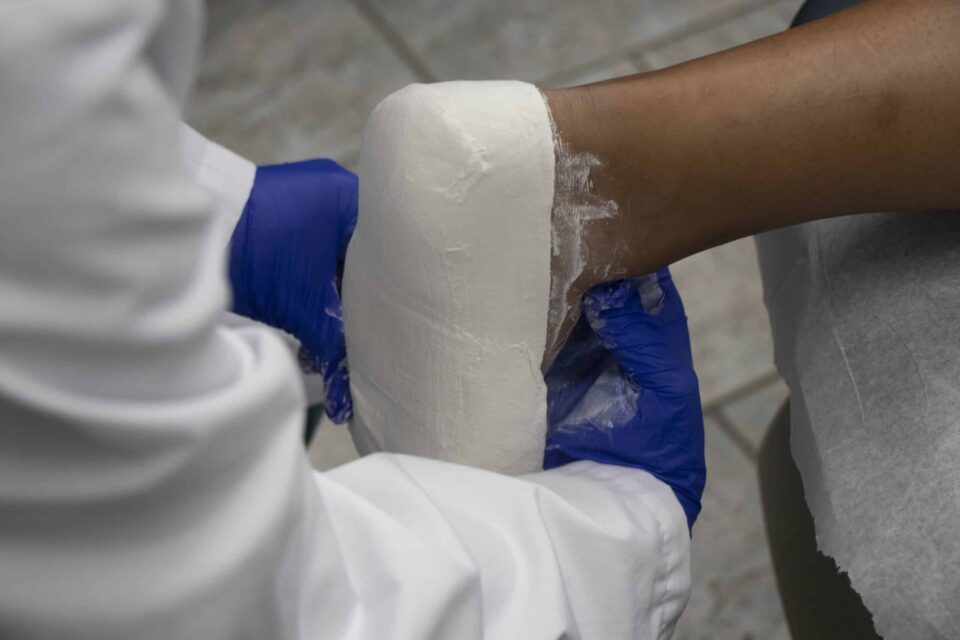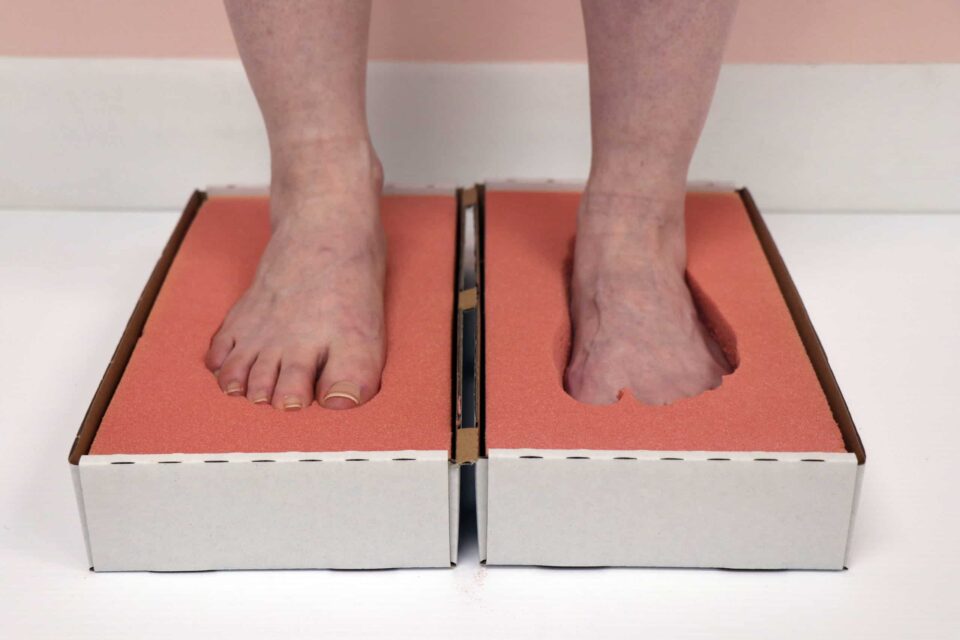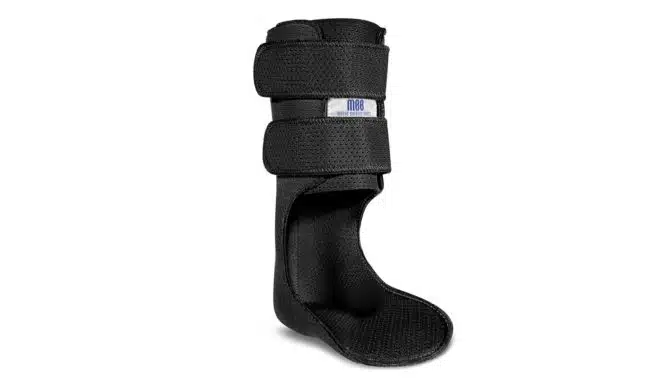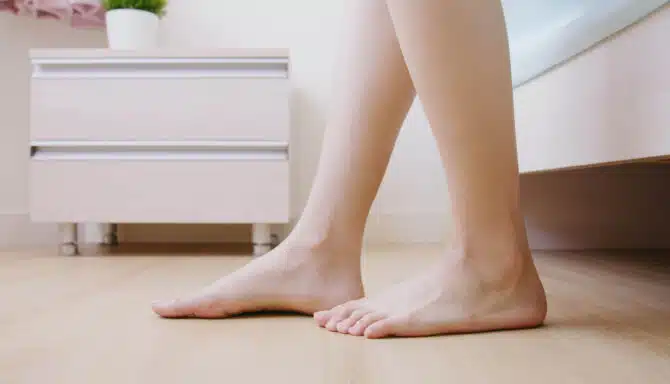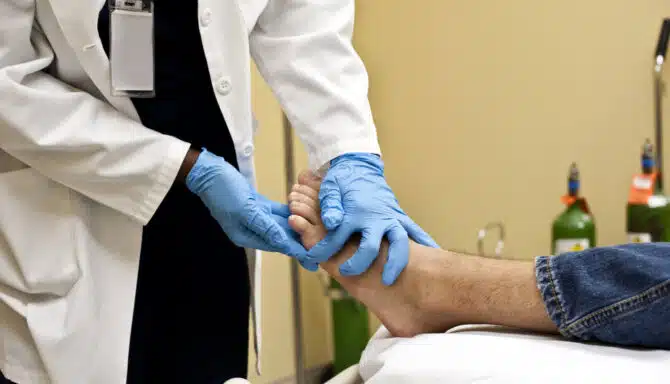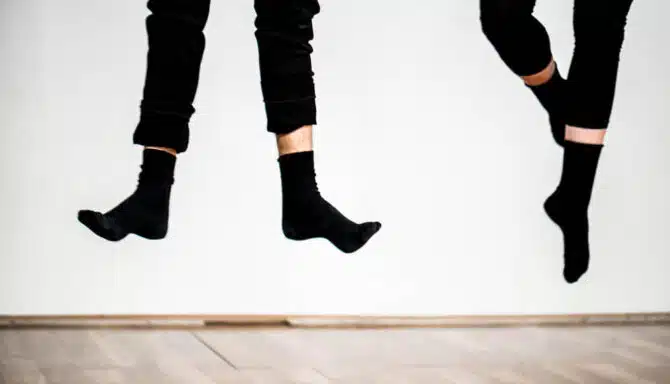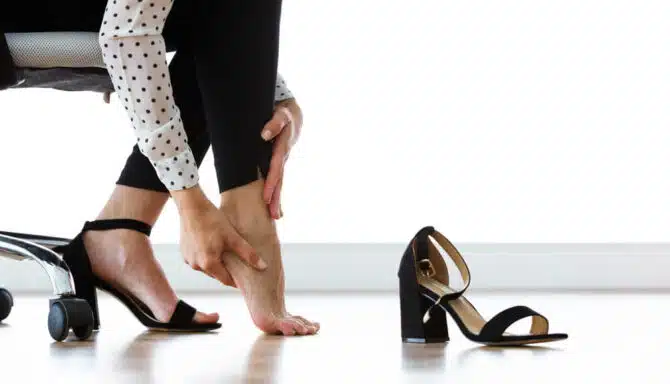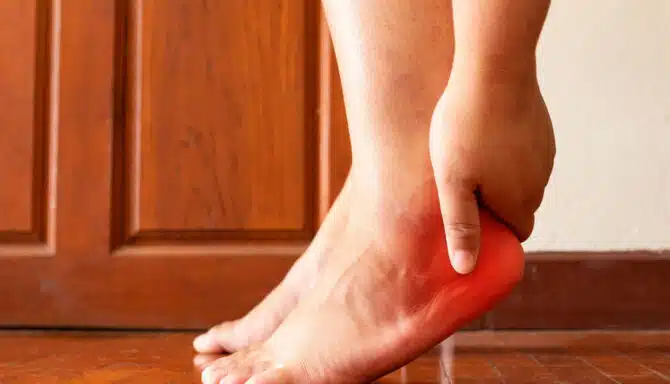July 10, 2025
What is an Ankle Foot Orthotic (AFO)?
An ankle foot orthotic (AFO) is a medical-grade brace that supports the foot and ankle. It often extends partway up the calf. Unlike regular foot orthotics—which fit inside shoes to support the arch and heel. AFOs offer external stabilization of both the foot and ankle joints.
AFOs are commonly made of lightweight plastic or carbon fiber and may be custom-made or prefabricated. They assist walking, correct alignment, reduce pain, and help prevent further injury.
Who Needs an AFO?
Image from https://braceworks.ca/ and the Washington Post
AFO's received mainstream attention a few years ago when NFL quarterback Alex Smith returned to the football field after a catastrophic leg injury. The key to his return: an ankle foot orthotic. Due to a post-surgical infection, the nerve that helps flex the right foot was severed. This meant he couldn't lift his foot. So he got an AFO to help and made a brief comeback (with the help of an extensive rehab team).
So who exactly needs an AFO? Since AFOs are heftier than regular orthotics, they're typically recommended for patients with more complex conditions than those addressed by traditional foot orthotics. You might benefit from an AFO brace if you have:
Foot drop (difficulty lifting the front of the foot)
Cerebral palsy or neuromuscular disorders
Stroke-related gait issues
Multiple sclerosis (MS)
Post-surgical ankle instability
Tendon or ligament injuries
Severe arthritis affecting ankle mechanics
Ankle foot orthotics are most commonly indicated for neuromuscular disorders and foot drop.
AFOs v Regular Orthotics: What's the Difference?
FeatureRegular OrthoticsAnkle Foot Orthotics (AFOs)ScopeFoot support onlyFoot and ankle supportPlacementInside the shoe (underneath the foot)Worn underneath and around the foot, and around the ankleConditions TreatedArch pain, plantar fasciitis, overpronation, high arches, other biomechanical irregularitiesNeurological and structural gait disorders, severe instabilityCustomizationOften custom-fit or prefabOften custom-molded to leg shapeMobility SupportModerateHigh—can aid in walking and balance
While regular orthotics focus on redistributing pressure and correcting foot mechanics inside the shoe, AFOs provide external control for more complex biomechanical or neurological issues. Think of it as the difference between cushioning a sore spot and physically guiding your limb’s motion.
How Are AFOs Made and Fitted?
https://www.youtube.com/watch?v=nA_QklH7AWY
AFOs are usually prescribed by a foot specialist or chiropodist after a full assessment. The process may include:
Biomechanical Assessment
Gait analysis
Casting or 3D scanning
Custom fabrication
Fitting and adjustments
Some patients may only need short-term use post-injury or surgery, while others may rely on AFOs for long-term mobility support.
Final Thoughts
If you’ve been told you need more than just arch support or if your walking pattern has changed due to injury or illness, an ankle foot orthotic could be a game-changer. At our clinic, we assess your full biomechanics and work with you to find the right support—whether that’s a custom orthotic, AFO, or a combination of both.
March 13, 2025
Flat feet are a condition in and of themselves. However, flat feet also have an impact on future foot health and can lead to other more painful foot conditions. But can flat feet really cause bunions? While it seems unlikely that a toe deformity can be linked to a flat arch, you'd be surprised how interconnected our lower extremities are, especially the feet! Today’s article will explore how flat feet cause bunions, what you can do to prevent them, and how a foot specialist like a Chiropodist or Podiatrist can provide treatment.
What are Flat Feet?
Flat feet, or pes planus, cause the entire sole or most of it to contact the ground when standing and walking. For some people, this condition can extend into adulthood from childhood (children have flat feet before the arch forms) when the arch fails to form.When you have normal arches, they provide an elastic, springy connection between the forefoot and the hindfoot, allowing forces incurred during weight-bearing to be distributed properly. When these arches don’t exist, this mechanism is disrupted, leading to pain and other complications.
What are Bunions?
https://www.youtube.com/shorts/sXF8lWHad0g
Bunions, or hallux valgus, are bony protrusions that form on the inside edge of the first metatarsophalangeal (MTP) joint at the base of the big toe. They develop when pressure causes the big toe to deviate toward the second toe, resulting in a misalignment of the joint. Emerging research indicates that hypermobility in the midfoot (specifically the mid-tarsal joint between the navicular and the base of the first metatarsal) may be a key underlying factor in the development of bunions, and this hypermobility is often genetic.
Common Bunion Causes and Risk Factors:
Ill-Fitting Footwear: Wearing the wrong shoes for years is a major risk factor for most foot conditions, especially bunions. Wearing tight, narrow, or high-heeled shoes can exacerbate pressure on the big toe joint, contributing to bunion formation. Your toes need space to splay and rest comfortably!
Gender and Age: Women, particularly those over 60, are more prone to developing bunions, generally due to decades spent making poor footwear choices, or possibly due to hormonal influences that affect the ligaments in the foot.
Inflammatory Conditions: Diseases like rheumatoid arthritis can cause joint inflammation, which increases stress on the big toe and the risk of bunions.
Foot Injuries: Trauma to the foot can alter its mechanics, leading to bunion development.
https://www.youtube.com/shorts/KZiVzLyBUMo
Flat Feet and Bunions: The Connection
If you’re not proactive, the shape of your foot arch can have a big impact on our foot health over time. You may know that flat feet can lead to plantar fasciitis, and you may also know that high arches can lead to back pain, but our arch shape can affect us in countless ways. Let’s talk about the science behind why a flat foot can lead to a painful bunion.
It all boils down to flat feet causing an abnormal gait (walking pattern), and the damage caused by walking with that abnormal pattern for a long period of time.The structural anomaly of flat feet and barely having an arch, or no arch at all, can significantly impact foot mechanics—particularly during walking. In a typical gait cycle, the foot pronates (rolls inward) to absorb shock and then supinates (rolls outward) to create a rigid lever for propulsion. Individuals with flat feet often experience overpronation, where the foot remains excessively rolled inward during the push-off phase. The altered biomechanics increases pressure on the first MTP joint, leading to instability and misalignment. Over time, this persistent stress can cause the big toe to deviate toward the second toe, resulting in a bunion.
Moreover, flat feet can lead to muscle imbalances that exacerbate bunion formation. Weakness in the intrinsic foot muscles (a group of tiny muscles inside the foot) and the tibialis posterior muscle (a muscle in your lower leg) compromises arch support, worsening overpronation. This chain reaction places additional strain on the big toe joint, accelerating bunion development. Therefore, the combination of altered foot mechanics and muscle imbalances associated with flat feet plays a significant role in the development and progression of bunions.
https://www.youtube.com/shorts/pdyv58z1D2Y
Preventing Bunions With Flat Feet
First and foremost, it’s all about the shoes! Selecting footwear that fits properly with a wide toe box and adequate arch support is crucial. A spacious toe box prevents crowding of the toes, reducing pressure on the big toe joint and minimizing the risk of bunion formation. Adequate arch support helps maintain proper foot alignment, distributing weight evenly and alleviating stress on MTP joint. Avoiding high heels and narrow shoes is essential, as they can exacerbate foot misalignment and increase the likelihood of developing bunions.
Incorporating custom orthotics can provide even more arch support if you have flat feet. These orthotics help correct overpronation—which we know now is a common issue—by stabilizing the foot's movement during the gait cycle and keeping it in neutral alignment. By improving foot alignment, orthotics reduce undue pressure on the big toe joint, reducing your risk of bunion development.
Lastly, Engaging in specific exercises can strengthen the muscles supporting the foot arch, enhancing stability and function. These exercises should aim to:
Strengthen Foot Muscles: Targeting the intrinsic and extrinsic muscles of the foot to provide better support for the arch and improve overall foot stability.
Improve Flexibility: Enhancing the range of motion in the toes, feet, and ankles to prevent stiffness and reduce strain on the MTP joint.
Enhance Balance and Coordination: Developing proprioception to ensure proper foot placement and gait mechanics, thereby reducing the risk of misalignment.
Regular practice of these exercises can improve foot biomechanics, reduce overpronation, and subsequently lower the risk of bunions. See below for an example of a great flat foot exercise.
https://www.youtube.com/shorts/whJ3TZAOn00
Foot Clinic Bunion Care
If you already struggle with bunions and foot pain, don’t worry; there are plenty of options available to you.
Bunions cannot be reversed after they form, but they can be managed with guided care from a podiatrist or chiropodist. The goal is to avoid invasive surgical intervention while still preventing bunions from impacting your daily life as much as possible. Most of these bunion treatment options are available at our downtown Toronto foot clinic:
Footwear Modification. Wearing shoes with a wide toe box and avoiding high heels can help reduce pressure on the bunion. Orthopedic shoes designed to accommodate bunions provide additional support and comfort.
Anti-inflammatory Medication. Over-the-counter NSAIDs, such as ibuprofen, can help reduce inflammation and alleviate pain associated with bunions.
Bunion Splints and Aligners. Devices like bunion splints and toe spacers can help realign the big toe and reduce discomfort. They can provide symptomatic relief, and you can try a more rigid device if your bunion is severe.
Therapeutic Taping. Applying tape to the foot can help maintain proper alignment and reduce strain on the bunion, providing temporary relief from pain and inflammation.
Shoe Stretching. Professional shoe stretching can create additional space in the shoe, reducing pressure on the bunion without altering the overall size of the footwear.
Supportive Insoles or Custom Orthotics. Custom orthotics can provide support to the arches and correct faulty biomechanics. This can potentially slow the progression of bunions by reducing pressure on the first MTP joint.
Bunion Exercises. Strengthening foot muscles through specific exercises can improve joint stability and decrease bunion-related pain. Try these 5 simple exercises for bunions.
Shockwave Therapy: This non-invasive treatment can address tight muscles and soft tissue injuries associated with bunions. This can potentially reduce pain and improve function.
Implementing these non-surgical interventions can significantly alleviate discomfort and slow the progression of bunions, enhancing overall foot health and quality of life.
https://www.youtube.com/shorts/8g43ZWreZ1g
March 6, 2025
Figuratively speaking, it’s a good thing to have “thick skin,” right? But if you have palmoplantar keratoderma, it’s a different story. This condition, sometimes shortened to PPK, refers to a group of foot skin disorders characterized by thick, rough, and yellowed skin on the hand palms and feet soles. These conditions can be either inherited or acquired. In today’s article, we’ll explore the symptoms, causes, and, most importantly, the treatment options available. This type of skin thickening may warrant a trip to a foot clinic and the expertise of a foot care professional, such as a Chiropodist or Podiatrist. However, successful treatment may depend on the underlying cause of the skin thickening.
What is Palmoplantar Keratoderma?
This condition combines two scientific terms: palmoplantar, which specifically refers to the skin on the soles of the feet and the palms of the hands, and keratoderma, a term for epidermis (skin) thickening. In less common cases, transgradient keratoderma can affect the top of the hands and feet. The feet are usually more severely affected than the hands.
Palmoplantar keratoderma (PPK) causes thickened skin on the palms and soles due to an overproduction of keratin, the protein that forms the outer layer of the skin. Normally, keratin helps protect the skin from friction, pressure, and environmental damage. However, in PPK, something disrupts the balance of keratin production and shedding, leading to excessive buildup.
This happens because of genetic mutations or external factors that affect how skin cells grow and mature. Inherited forms of PPK often involve mutations in genes that control keratin formation or the connections between skin cells. These mutations make the skin cells more resistant to breaking down, so they pile up instead of naturally shedding.
Since the palms and soles experience the most pressure and friction in daily life, they are especially prone to this excessive keratin buildup. Over time, the thickened skin can cause pain or become hard and cracked, depending on the severity of the condition. Some types can also cause blisters to form.
Types of Palmoplantar Keratoderma and Associated Symptoms
https://www.youtube.com/shorts/-iNFLGednYY
Genetic (hereditary) keratoderma is usually divided into three main categories: diffuse, affecting the entire hand palm and foot sole; focal, where thickening is limited to pressure points; and punctate, which appears as small, hard lesions. Some genetic PPKs - particularly diffuse - are syndromic, meaning they are associated with other health conditions and additional symptoms, ranging from hearing loss to nail abnormalities to internal organ damage.
Acquired PPK, on the other hand, is always syndromic and develops later in life due to external factors such as infections, inflammatory diseases, or underlying systemic conditions like internal malignancies. Acquired forms may be easier to treat since you and your healthcare team can address the underlying cause. Acquired PPK is also more common than genetic, since there are more causes and risk factors associated with it.
Most types of PPK cause varying degrees of thick skin, potential foot odor (as a result of sweat combined with thick skin) and yellow/discoloured skin.
Genetic PPK Types and Symptoms
Diffuse PPK
This form presents with even thickened skin on the palms and soles, often with a red border at the edges. Symptoms typically appear in early childhood and may include excessive sweating (hyperhidrosis). The thickening is usually confined to the palms and soles, without extending to the tops of the hands or feet.
Focal PPK
This type is characterized by linear (striate) thickened areas on the palms and soles, often following the lines of skin tension. It is typically caused by mutations in genes encoding desmosomal proteins, which are crucial for cell adhesion. A specific type of focal PPK called Pachyonychia Congenita is a rare genetic disorder that can also cause thick toenails.
Punctate PPK
This form is characterized by multiple small, hard, corn-like lesions scattered on the palms and soles. It is associated with mutations in genes that play a role in skin cell function.
Acquired PPK Types and Symptoms
PPK from Infections (syphilis, etc)
Rough, scaly and yellow thickening on the palms and soles.
May come with a rash or other symptoms affecting the whole body.
Clears up when the infection is treated.
PPK from Inflammatory Skin Conditions (psoriasis, eczema)
Thickened, inflamed skin with redness and scaling.
Can extend beyond just the palms and soles.
Often improves with medicated creams or treatments that calm the immune system.
PPK Linked to Other Health Conditions (cancer, hormone disorders)
Yellow thickening of the palms and soles that appears suddenly in adulthood.
Can sometimes signal an underlying health issue, like cancer.
Needs further medical evaluation to check for possible internal diseases.
What is the Difference Between Palmoplantar Keratoderma and Calluses?
PPK is not the only cause of skin thickening on the feet and hands. In fact, it is more rare than another common culprit: calluses. But how do you know which condition you have?
Calluses are localized areas of thickened skin that develop as a protective response to repeated friction or pressure. Commonly found on individuals who are physically active or spend long hours wearing ill-fitting shoes, they are much less severe than PPK.
PPK tends to be thicker and more noticeable, alarming and unsightly than calluses, often covering a larger, symmetrical area on the palms and soles. It can appear hard and more yellow, or red and flaky. In some PPK cases, you may observe a red band at the edges of the thickened skin. Calluses can have a more mild appearance (but not always; they can sometimes be thick and painful!), with some people not even realizing they have them.
Does that mean that PPK is the same as having excessive calluses? Not exactly. Calluses are only caused by friction and pressure----whereas PPK always has a driving force behind it, whether it's a genetic mutation or the result of an illness.
https://www.youtube.com/shorts/yBACD8bUim0
Palmoplantar Keratoderma Treatment: Can a Chiropodist or Podiatrist Help?
While there is no outright cure for certain forms of PPK, Chiropodists and Podiatrists can help manage symptoms, reduce discomfort, and improve mobility. This typically involves regular debridement (carefully removing excess skin), possibly prescribing medicinal products, and offering footwear advice to minimize friction and pressure. The latter may also include prescribing custom orthotics to properly distribute pressure on the bottom of the feet, especially if the thickened skin is impacting daily life. Scheduling an initial assessment is a good start!
Naturally, since PPK can be linked to an underlying condition, more comprehensive care may be needed. A Chiropodist or Podiatrist might become a part of a broader team of healthcare professionals that can help you, including a dermatologist, your family doctor or other specialists trained to tackle the root cause. You may need advanced treatments such as topical retinoids, corticosteroids, or even laser therapy in some cases.
https://www.youtube.com/shorts/sBIdll7qylQ
February 27, 2025
Dealing with high arches and back pain can be a challenging combination, as the two are more connected than they seem. Understanding how high arches contribute to back pain is key to finding effective treatments and preventing further issues. Whether you’re dealing with foot pain, back pain, or posture problems, addressing high arches can significantly improve overall comfort and protect the rest of your body—especially your back.
What are High Arches?
https://www.youtube.com/shorts/osC-UmBtgNk
High arches (or cavus foot or pes cavus) is a condition where the foot has an abnormally pronounced arch (as opposed to a flat foot or a normal arch).
Having high arches can be due to simple genetics, inheriting structural abnormalities in the foot from your parents. They can also be caused by several neuromuscular disorders, which are conditions (ranging from mild to severe) that cause dysfunction or muscle weakness and leave certain muscles inactive.
High arches generally develop during or after childhood when the flat feet most children have start to take shape and the foot arch forms. In some cases, idiopathic pes cavus occurs without a known cause (like genetics or neuromuscular disorders), and is just a case of simple variations in bone and ligament structure.
A pronounced foot arch is usually quite discrete, aesthetically, and isn’t a serious condition. However, high arches are a common cause of foot pain and discomfort. High arches put extra pressure on the heel and ball of the foot, affecting normal pressure distribution and making it harder to absorb shock properly. This can lead to heel pain (plantar fasciitis— which is also commonly linked to flat feet feet), arch pain, and more, as the muscles and ligaments supporting the foot work overtime to stabilize each step, leading to inflammation or strain.
High arches often cause the foot to roll outward, a motion known as supination. This can place extra stress on the ankles and knees, further disrupting alignment and increasing the risk of injuries like sprains and shin splints.
It’s important to schedule an assessment with a foot specialist, like a podiatrist or chiropodist, if having high arches affects your daily life.
The Connection Between High Arches and Back Pain
https://www.youtube.com/shorts/7m3SQ5dXaeg
A pronounced arch can also lead to back pain. But how do high arches affect the back when the two areas seem relatively far apart?
The answer lies in how the body stays balanced. Many foot problems, not just high arches, often cause back pain—along with knee, leg, and ankle discomfort—because the feet serve as the body's foundation (carrying your weight) and closest connection to the ground. When that foundation is misaligned and overworked, the entire body has to compensate, leading to strain in other areas. Simply put, everything is connected, and the feet play a crucial role in maintaining functionality throughout our body’s kinetic connection!
When it comes to the back, pain and poor posture often coexist. As we know, when the arches are too high, they can throw off the body's natural alignment, affecting the way you stand and walk. Uneven weight distribution forces the lower body to compensate, which can lead to foot pain and posture issues over time. The strain on the feet may cause the ankles to supinate, shifting stress to the knees and hips. This misalignment can travel up the spine, making it harder to maintain proper posture and increasing the risk of chronic discomfort.
Without proper shock absorption, the impact of each step travels up through the joints, leading to tension in the lower back and shoulders. Over time, these small imbalances can create lasting posture problems, making everyday movements more difficult.
Treating High Arches and High Arch-Related Back Pain
When you treat high arches, you’re also preventing any potential back pain that may occur further down the road. But if you already struggle with high-arch related back pain, you can still focus on treatment methods that simultaneously target both issues.
Video Gait Analysis
https://www.youtube.com/shorts/Rhuga6vLdc0
This is when a Chiropodist or Podiatrist assesses your walking patterns (also known as your gait) using video gait analysis equipment. It can give foot care professionals insight into the potential damage your high arches could cause, so they can recommend preventative treatments.
Custom Orthotics and Insoles
A Podiatrist or Chiropodist can prescribe custom orthotics that you can wear inside your shoes. They will provide much-needed arch support, distribute weight evenly, and reduce strain on the feet and spine. Another option is over-the-counter Superfeet insoles, with the Superfeet Green: All Purpose High Arch being a good choice to ask your foot specialist about.
Supportive Footwear
Look for shoes with good arch support, cushioning, and shock absorption to minimize impact on joints. People with high arches should wear shoes with flexible midsoles or rocker soles to improve movement and reduce strain. Cushioning running shoes with shock absorption help counteract supination, ensuring even pressure distribution and healthy biomechanics. Avoid high heels, rigid soles, and unsupportive flats, as they can increase discomfort.
Read more about the link between footwear and back pain.
Stretching and Strengthening Exercises
https://www.youtube.com/shorts/-EeyHTdkrEs
Targeting the feet, calves, and lower back can improve flexibility and stability, reducing pain. Some of the best include towel stretches (where you place a towel under your foot arch and pull towards you), seated toe pulls (pulling the top of your foot towards you - see above!), ankle circles and massage ball rolls (rolling your foot arch on a therapeutic massage ball). You can read more about them, including how to perform them, here. You can also try clamshells on an exercise mat with your ankles together (this will also help soothe hip pain. See below for a demonstration!
https://www.youtube.com/shorts/ZODK0Q4zOws
January 9, 2025
Living with high arches can be a challenge, but if you pay attention to your foot health, you can manage them effectively. Let’s explore what high arches are, their impact, and our top 4 tips for living with high arches.
What Are High Arches?
https://www.youtube.com/shorts/13rmyA18ZzY
High arches (pes cavus) is a condition where one has - you guessed it - abnormally high foot arches. They are essentially the opposite of flat feet, which are characterized by having a minimal or non-existent arch. High arches may be hereditary or caused by neurological disorders such as Charcot-Marie-Tooth disease.
From a biomechanical perspective, the raised arch reduces the surface area in contact with the ground, which can result in an uneven distribution of weight across the foot. High arches often place excessive pressure on the ball and heel of the foot, leading to discomfort, instability, potential injuries and chronic foot conditions. High arches also impairs shock absorption, which causes progressive wear-and-tear on the joints over time.
Side effects of high arches include foot pain, issues like calluses and hammertoes, and an increased risk of ankle sprains. Individuals can also develop conditions like plantar fasciitis (this can also frequently occur in people with flat feet), or Achilles tendonitis due to the strain placed on the muscles and ligaments. The lack of shock absorption can also reverberate up the body and lead to joint disorders like arthritis.
High arches are associated with supination, also called underpronation, a condition where the foot rolls outward during movement. This gait pattern places additional stress on the outer edges of the foot and ankle, leading to instability and overuse injuries. Consequently, individuals with high arches should pay close attention to their walking or running patterns to prevent long-term complications.
High arches can also lead to changes in posture and gait. This, combined with the lack of shock absorption, may result in secondary issues such as knee, hip, or back pain over time.
Tips for Living with High Arches
https://www.youtube.com/shorts/2et0ZUSx4OM
Living with high arches requires thoughtful adjustments to your daily routine and habits. Here are some ways to keep your feet comfortable and supported:
1. Choose the Right Footwear
Proper footwear is essential for managing high arches. Opt for shoes with ample shock absorption, arch support and cushioning. Shoes with flexible midsoles or rocker soles can also be very helpful: People with high arches tend to have rigidity in the toes and ankles due to joint wear-and-tear, which means the toes and ankles do not flex as much as it should during the gait cycle. A flexible midsole and rocker sole counteracts this and make movement easier. Likewise, people with high arches should avoid high heels, rigid soles, and unsupportive flats, which can exacerbate discomfort.
Due to supination, people should look for cushioning running shoes. These provide balanced cushioning and plenty of shock absorption and flexibility to support the foot’s natural motion and healthy biomechanics. This design helps distribute pressure evenly, enhances comfort, and reduces the risk of injury.
2. Wear Custom Orthotics
Custom orthotics are a valuable tool for redistributing pressure evenly across the foot. You can work with a specialist, like a podiatrist or chiropodist, at a foot clinic to create orthotics tailored to your specific needs.
Scientifically, custom orthotics help correct abnormal biomechanics, such as excessive supination, by stabilizing the foot and encouraging a more neutral gait. They can also provide added cushioning to reduce the impact of your stride on your joints. Over time, this can alleviate pain, reduce fatigue, and prevent the development of secondary issues in the knees, hips, or lower back.
3. Maintain a High Arch Foot Care Routine
Foot baths and massages can soothe foot pain, relax the muscles in your feet and boost blood circulation.
Soak your feet in warm water with Epsom salts, or foot bath products from reputable companies like Gehwol, to alleviate tension. Gehwol products, such as their Herbal Foot Bath, are available to buy at our Toronto foot clinic, Feet First Clinic!
Gently massage the arch, heel, and toes to improve circulation and relieve tightness. Read this article to learn how to give yourself a foot massage from home.
4. Try Stretching and Strengthening Exercises
Foot stretches and exercises play a crucial role in managing high arches by improving flexibility, reducing muscle tightness, and promoting better blood circulation in the feet. High arches can lead to stiffness and imbalances in the tendons and muscles, increasing the risk of discomfort and injury. Over time, these stretches can support better alignment and strengthen the foot's ability to handle daily stress, making them an essential part of high arch foot care.
Here are some simple routines you can try today!
Toe Flex and Raise: While standing, plant your toes and lift your heels off the ground. Hold for 15-30 seconds and repeat 5 times.
Seated Towel Stretch: Loop a towel around your foot and gently pull it toward you, holding for 15-30 seconds.
Pen Pick-ups: Stay seated. Then, lay three pens, or similarly shaped objects, in front of you–spaced apart evenly. Using your toes, pick up each pen and place it in a bowl.
Seated Toe Pulls: Sit on a chair and cross one ankle over the opposite knee. Grab the top of your foot and gently pull it toward your body until you feel a stretch on the top of your foot. Hold for 15-30 seconds and repeat 2-3 times per foot.
https://www.youtube.com/shorts/-EeyHTdkrEs
Additional High Arch Pain Relief Tips
More practical approaches for high arch pain relief include:
Ice Therapy: Apply an ice pack to sore areas for 15-20 minutes to reduce inflammation and soothe discomfort. If your feet are particularly painful, take this one step further by practicing the RICE method (Rest, Ice, Compression and Elevation).
Supportive Inserts: Use over-the-counter insoles with firm arch support. A good choice for high arches is the Superfeet Green or the Superfeet Run Cushion High Arch insoles. However, talk to a podiatrist or chiropodist about if you need more customized support from orthotics.
Medication: Nonsteroidal anti-inflammatory drugs (NSAIDs) may help manage pain.
Seek Professional Help: Visit a podiatrist or chiropodist for a biomechanical assessment to determine how prominent your high arches are, how they are affecting your body, and any contributing biomechanical factors. These foot specialists can also fit you for custom orthotics, provide shoe recommendations and curate a full treatment plan.
When to See a Specialist For High Arches
If high arches are causing persistent discomfort or limiting your mobility, it’s essential to seek professional advice. As we mentioned, visiting a foot clinic ensures access to personalized treatment plans. Consulting a foot specialist is especially important if you notice:
Increased frequency of ankle instability or sprains.
Development of deformities like hammertoes, claw toes, or bunions.
Chronic pain that makes simple activities like walking increasingly difficult.
A foot specialist can recommend the appropriate treatments, depending on the severity of your condition. They may also suggest physical therapy to improve balance, coordination, and overall foot function.
Regular check-ups and assessments with a podiatrist or chiropodist can prevent seemingly minor issues from becoming major concerns. Don’t hesitate to seek their expertise!
https://www.youtube.com/shorts/XZUfVhny5pY
December 12, 2024
Flat feet and plantar fasciitis are closely linked, with flat feet often contributing to the development of plantar fasciitis. Both conditions can also lead to foot pain and mobility issues, and can worsen over time if not properly addressed. Today’s article will answer:
What are flat feet?
What is plantar fasciitis?
What is the connection between flat feet and plantar fasciitis?
How can I treat flat feet and plantar fasciitis?
What are Flat Feet?
Flat feet, scientifically called pes planus, is a condition where you have a very minimal or non-existent foot arch. It is one of three arch types, the others being a normal arch and a high arch. If you have flat feet, your entire sole is in constant contact with the ground when you aren’t wearing shoes.
Most children naturally have flat feet but grow out of it as they get older. If you don't grow out of it by adulthood, it is called congenital flat feet.
Some adults may also have normal arches that collapse. This condition, which may affect one or both feet, is sometimes called adult-acquired flatfoot or fallen arches (both commonly referred to as simply flat feet or flatfoot), and may be asymptomatic. However, it often results in discomfort, foot pain and biomechanical issues.
Many people may not realize they have an abnormal arch or how it affects the rest of our body. That’s why it’s important to talk to a podiatrist or chiropodist whenever you experience foot pain. They can determine whether your pain is directly linked to your foot type and arch structure before offering the appropriate treatment.
Causes of Adult-Acquired Flat Feet
Common causes of adult-acquired flat feet are:
Posterior Tibial Tendon Dysfunction (PTTD): PTTD is a medical condition involving damage, weakening, or inflammation of the posterior tibial tendon, which supports the arch of the foot. It is one of the leading causes of fallen arches in adults. Left untreated, PTTD can progress to foot arch pain and flat feet, often in only one foot.
Aging: As you age, the ligaments, tendons, and muscles in your feet lose elasticity and strength. This natural wear and tear can result in the gradual flattening of the arch.
Obesity: Extra body weight increases pressure on the feet, especially the arches. This additional load can accelerate the breakdown of the foot’s structures, leading to flat feet.
Rheumatoid Arthritis: This condition can affect the joints and soft tissue in the foot, weakening the ligaments and structures that support the arch, and leading to its collapse.
Injury or Trauma: Injuries to the foot or ankle, such as fractures or sprains, can damage the tendons or ligaments that support the arch. This can disrupt the foot's normal structure and collapse its arch.
Pregnancy: Hormonal changes during pregnancy can relax the ligaments in the body, including those in the feet. This can cause the arch to flatten, often temporarily, but it may persist in some women after childbirth.
Overpronation
Flat feet are a structural issue. Think of a normal arch as an important component of a home; when it is lacking, your foot’s utility and functionality will be affected, as well as your mobility. This means you may subconsciously start walking in an abnormal way to make up for the absent arch and accommodate foot pain, which causes even more damage over time. For people with flat feet, this movement is called overpronation.
When you overpronate, the foot rolls too far inward during walking or running, and becomes a consistent feature of your gait (your walking pattern). This leads to uneven pressure distribution which can cause pain and contribute to injuries in the feet, ankles, knees, back and hips.
What is Plantar Fasciitis?
https://www.youtube.com/shorts/rSKd2ztKWa8
Plantar fasciitis is technically an overuse injury. It targets the plantar fascia, which is a long, fibrous ligament (or band of tissue) that runs along the toes to the heel, connecting the bones of the foot.
The plantar fascia also operates as a dynamic support mechanism for the foot’s arch, distributing forces evenly during movement. When overused, it may lose elasticity and develop microtears, typically near its attachment point at the heel. This then leads to inflammation, your body’s natural response to injury.
If untreated, plantar fasciitis can lead to impactful gait changes, prolonged foot pain, and secondary issues in the knees, hips, or lower back.
Plantar Fasciitis Symptoms
Heel Pain (especially in the morning): This is a hallmark symptom. During rest, the plantar fascia tightens. When taking your first steps after waking, the tissue is suddenly stretched, leading to sharp pain. As the fascia warms up, the pain often decreases.
Pain after prolonged standing or activity: Standing for long periods or engaging in weight-bearing activities places repetitive strain on the plantar fascia. This results in pain that often intensifies after the activity ends.
Tenderness or stiffness in the heel area: The attachment point of the plantar fascia to the calcaneus (heel bone) is a common site for inflammation and microtears, leading to localized stiffness and tenderness, especially after inactivity.
Swelling in the heel or arch: Inflammation from repeated stress might cause fluid accumulation in the affected area, causing visible or palpable swelling as the body tries to repair itself.
Worsening pain with barefoot walking or unsupportive shoes: Walking barefoot or wearing shoes without adequate arch support increases strain on the plantar fascia.
Foot arch pain: Inflammation of the plantar fascia can irritate nearby areas, causing burning or aching sensations along the length of the fascia in the arch of the foot.
https://www.youtube.com/shorts/fTIAlew5T04
The Connection Between Flat Feet and Plantar Fasciitis
Studies suggest that you are more likely to develop plantar fasciitis if you have flat feet versus a normal arch, making flat feet a top risk factor for plantar fasciitis.
This is mainly because the foot and gait mechanics associated with flat feet put excess strain and pressure on the plantar fascia. In a normal foot, the arch acts as a natural shock absorber, distributing weight and reducing stress on the plantar fascia. However, since people with flat feet have a low or entirely absent arch, it disrupts this natural shock absorption from occurring.
Overpronation also strains the plantar fascia, causing microtears and inflammation over time. Additionally, the misalignment caused by flat feet can lead to uneven weight distribution, increasing stress on the plantar fascia and exacerbating the condition.
These factors can also place additional strain on surrounding structures, such as the Achilles tendon, which will worsen the overall tension in the plantar fascia.
Additional Plantar Fasciitis Causes and Risk Factors
Aside from people with flat feet, plantar fasciitis is also common in:
Middle-aged Adults: Particularly those aged 40 to 60, as natural wear and tear over time can weaken the plantar fascia.
Athletes: Runners, dancers, and those involved in high-impact sports are at increased risk due to repetitive stress on the plantar fascia.
People with high arches: Having a high arch, the polar opposite of a flat foot, can also cause plantar fasciitis due to increased strain on the plantar fascia and excessive supination (when the foot rolls excessively outward during walking and running).
People struggling with obesity: Carrying extra weight increases pressure on the plantar fascia, especially during standing or walking.
Workers who stand for long hours: Healthcare workers, factory employees, restaurant staff, construction workers and more are at a higher risk due to the repeated strain from standing.
Plantar Fasciitis and Flat Feet: Treatment
If you’re looking for flat feet and plantar fasciitis pain relief, visiting a foot specialist, like a podiatrist or a chiropodist, is your best bet. These experts can provide education, treatment services, and “homework” ideas you can incorporate in your daily routine. Keep reading to learn ways you can manage both issues!
Exercises and Stretches
https://www.youtube.com/shorts/7-XrzvpxETc
Performing light, simple and effective routines can help strengthen the plantar fascia and manage heel and foot arch pain. Here are some you can try:
Seated toe pulls: Sit with one foot crossed over the opposite knee and use your hands to gently pull your toes towards you for 30 seconds. Repeat with the other foot.
Towel pickups: Stand with your feet flat on the floor and a towel placed in front of you. Use your toes to scrunch the towel towards you, then relax. Repeat for 30 seconds, then switch feet.
Calf raises: Stand on a step, rise onto your toes, then slowly lower your heel back down. Repeat for 8-10 reps, completing 3 sets.
Read a more detailed article on the best exercises for plantar fasciitis.
Proper Footwear
Wearing the right footwear is essential for managing both flat feet and plantar fasciitis. The key features to look for include:
Arch support: Arch support is the cornerstone of plantar fasciitis treatment. This will keep the plantar fascia properly supported and reduce strain. Arch support also provides stability and helps prevent the overpronation (excessive inward rolling of the foot) that can strain the plantar fascia.
Cushioning: Helps absorb shock, reducing the impact on the heel and alleviating discomfort.
Firm heel counter: Supports the back of the foot, preventing excessive movement and ensuring stability when walking or standing.
Comfortable fit: Ensures the shoe isn’t too tight or too loose. You want to ensure shoes also provide ample space for the toes to prevent overcrowding. This reduces pressure points, allows for proper alignment (which is crucial for people with flat feet) and offers overall comfort.
Midfoot support: Offers additional stability to prevent the arch from collapsing further, keeping the foot properly aligned and supporting a natural gait.
Rounded sole front: A rounded toe or sole at the front of the shoe (like a rocker sole) encourages a smoother toe-off during walking. It can also promote a more natural, efficient gait by allowing the foot to roll more fluidly from heel to toe.
Stability and motion control shoes: These are designed to address the unique needs of people with fallen arches and excessive overpronation to keep your feet in a neutral position during movement. They provide enhanced arch support while controlling foot and ankle motion with firmer midsoles and medial posts (a denser material on the inner side of the shoe), all the while reducing strain on the plantar fascia.
If these features seem overwhelming and you’re having trouble finding the right shoes, our one-stop-shop Toronto foot clinic offers complimentary shoe fittings.
Custom Orthotics
Foot clinics can provide custom orthotics. These are tailored to your foot’s personalized shape, are designed specifically for you and can be worn with many shoe types. For people with flat feet, they provide arch support and reduce excessive pronation. This can help alleviate the stress placed on the plantar fascia, reducing the risk of developing plantar fasciitis and helping alleviate the symptoms of the condition itself.
Shockwave Therapy
https://www.youtube.com/shorts/nt1SgT9xrUM
This is a non-invasive treatment for plantar fasciitis, and many other conditions as well! It takes minimal time and usually causes relatively little (if any) discomfort. Shockwave therapy works by transmitting low-intensity acoustic waves to the plantar fascia, which promotes healing. The process works by stimulating the body’s natural healing mechanisms, encouraging the repair of damaged connective tissue and the regeneration of cells in the affected area. Many studies find shockwave therapy to be an innovative, safe and effective treatment for plantar fasciitis.
More Treatment Options for Plantar Fasciitis and Flat Feet:
RICE method: Rest your foot, wrapped cold compression, and elevate the foot for 5 minutes then remove and wait 5 minutes for it to warm up then walk. This is a tried-and-true plantar fasciitis (and other injuries) treatment you can do from home!
Joint immobilization: Temporarily restrict movement to allow the inflamed plantar fascia to heal. This can be done with taping, bracing and splinting, or with a boot cast.
Heel cushioning. Reducing the pressure upon the heel from heel cushions
Foot Assessment with Video Gait Analysis: Involves recording and analyzing your walking or running pattern to identify abnormal foot mechanics, like overpronation.
Rolling a tennis ball or frozen water bottle under the foot: Another easy, soothing treatment method you can try at home.
